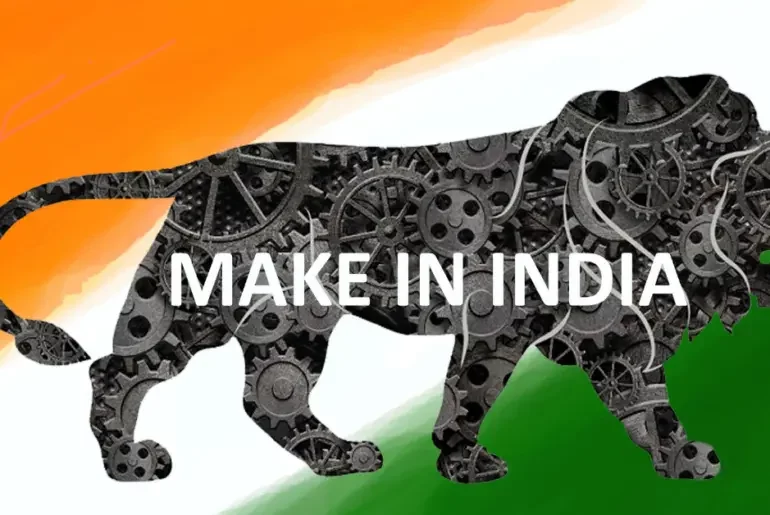Table of Contents
What is the Make in India Program?
The Make in India initiative was launched in 25th September, 2014 to generate employment and business growth opportunities, with a major focus on Indian start-ups. The initiative encourages domestic and international companies to choose India as a preferred manufacturing destination and a global manufacturing hub. It has helped improve foreign relations by providing better tax benefits and lower costs of production for international companies. The Make in India scheme focuses on job creation, skill enhancement, and innovation.
Make in India Logo
The Make in India logo features a lion made of cogs, symbolizing strength and manufacturing prowess. The lion represents India’s industrial growth and technological advancement. It signifies the country’s ambition to become a global manufacturing leader.
Key Objectives of Make in India
-
Boost Manufacturing: Strengthen India’s manufacturing sector with better infrastructure and technology, making India a preferred global destination.
-
Create Jobs: Generate employment opportunities through advanced skill development programs and improved domestic and foreign investments.
-
Stimulate Growth: Unlock India’s manufacturing potential by boosting the manufacturing sector’s contribution to GDP while building globally competitive industries.
-
Promote Sustainability: Encourage sustainable manufacturing practices and the use of renewable resources to ensure inclusive growth for communities.
-
Ease of Doing Business: Streamline regulations and leverage technology to foster a business-friendly environment with smoother operations.
What are the 4 Main Pillars of Make in India?
New Processes
The Make in India program streamlined the ease of doing business by removing bottlenecks through key technological interventions, like the eBiz portal and unified payment gateways. Simplified clearance mechanisms and an easy regulatory environment enhanced business operations and industrial growth.
New Infrastructure
The Make in India scheme has driven innovation through modern industrial corridors and urban development programs, such as the “100 Smart Cities” campaign. Along with improved communication and logistics networks, India has also secured the first position among 110 global investment destinations. The government has approved the development of 11 industrial corridors in four phases.
New Sectors
Foreign Direct Investment (FDI) has opened up to 27 key sectors across manufacturing, infrastructure, and services. Key industries include defense, medical devices, insurance, and construction, among others. Interactive portals and clear brochures have generated investor interest and developed a business-friendly climate. India has recently recorded the highest-ever FDI inflow of USD 83.57 billion in FY2021-22.
New Mindset
The Make in India initiative has proactively encouraged collaboration between the government and various industries, leading to an improved global standing. With these interventions, India has progressed to become the 7th most valued brand in the world.
What is Make in India 2.0?
Make in India 2.0 is the latest iteration of the government’s flagship Make in India initiative. It focuses on 27 specific sectors, with the Department for Promotion of Industry and Internal Trade (DPIIT) coordinating action plans for 15 manufacturing sectors, and the Department of Commerce overseeing 12 service sectors.
The advantage of Make in India 2.0 is a more targeted approach by identifying and developing key sectors. It aims to facilitate and attract investment, foster innovation, build world-class infrastructure, and create a conducive environment for domestic and foreign investment in these prioritized sectors.
Make in India Schemes
-
Production Linked Incentive (PLI) Schemes: Over USD 26 billion has been announced for 14 key manufacturing sectors to boost India’s manufacturing and exports.
- Pradhan Mantri Jan Dhan Yojana (PMJDY): The Pradhan Mantri Jan Dhan Yojana (PMJDY) is a mission aimed at achieving financial inclusion by providing accessible and affordable financial services to every citizen. These services include banking savings and deposit accounts, remittances, credit, insurance, and pensions.
-
PM GatiShakti & National Logistics Policy: PM GatiShakti has transformed the country’s industrial sector with a multimodal logistics network, while the National Logistics Policy aims to slash logistics costs by 10%.
-
Industrialization and Urbanisation: The government is developing Industrial Corridor Projects across 11 corridors (32 projects) in four phases to establish world-class manufacturing and investment destinations.
-
New Design, Innovation, and R&D: The ‘Startup India’ initiative fosters entrepreneurship and innovation for the benefit of startups in India. India is the third-largest tech-driven startup ecosystem globally, with the presence of 79,100 startups.
-
Discount on Tax: Tax rates have been rationalized, making India one of the most competitive global economies with one of the lowest tax rates in Asia.
-
Ease of Doing Business: The government recognizes ease of doing business as vital for promoting entrepreneurship and has undertaken several initiatives to create a business-friendly environment.
- International Solar Alliance (ISA): The International Solar Alliance (ISA) is an alliance of 121 countries, primarily located between the Tropic of Cancer and the Tropic of Capricorn. This initiative by India aims to promote research and development in solar technologies and formulate supportive policies.
What are the Major Sectors to be Focused Upon in Make in India 2.0?
Manufacturing Sectors
The 15 manufacturing sectors under Make in India 2.0 are:
-
Aerospace and Defence
-
Automotive and Auto Components
-
Pharmaceuticals and Medical Devices
-
Bio-Technology
-
Capital Goods
-
Textile and Apparels
-
Chemicals and Petrochemicals
-
Electronics System Design and Manufacturing (ESDM)
-
Leather and Footwear
-
Food Processing
-
Gems and Jewellery
-
Shipping
-
Railways
-
Construction
-
New and Renewable Energy
Service Sectors
The 12 identified service sectors under Make in India 2.0 are:
-
Information Technology and Information Technology Enabled Services
-
Tourism and Hospitality Services
-
Medical Value Travel
-
Transport and Logistics Services
-
Accounting and Finance Services
-
Audio Visual Services
-
Legal Services
-
Communication Services
-
Construction and Related Engineering Services
-
Environmental Services
-
Financial Services
-
Education Services
Benefits of the Make in India Scheme
The benefits of Make in India scheme in the Indian economy are:
-
Job Creation: Improved domestic manufacturing has led to better employment opportunities across sectors, thereby reducing unemployment and promoting inclusive growth.
-
Increased Exports: The Make in India program has enhanced the competitiveness of Indian products in the global market. It has improved exports and allowed a favorable trade balance.
-
Technological Advancement: Improved technologies, automation, and manufacturing innovations have promoted overall productivity and efficiency.
-
Improved Infrastructure: Developing industrial corridors, smart cities, and integrated logistics systems under the Make in India initiative have significantly developed the country’s integrated ecosystem. This facilitates smoother business operations and attracts more investments.
-
Boost to Domestic Manufacturing: By promoting local manufacturing, the program has reduced the country’s reliance on imports, strengthened the domestic industry, and contributed to self-reliance in critical sectors.
Challenges of the Make in India Program
-
Inexperienced workforce and inadequate emphasis on vocational training
-
Land acquisition bottlenecks, bureaucratic complexities, and inadequate infrastructure facilities
-
Limited access to finance, especially for small and medium businesses
Impact and Progress of the Make in India Initiative
-
Economic Growth Acceleration: Since the launch of the Make in India campaign in 2014, India has become a global growth leader with an impressive growth rate of 7.5%.
-
Increased Foreign Direct Investment (FDI): The initiative has made India an attractive investment destination. Key sectors such as defense, railways, construction, and insurance have opened up for foreign investment, fostering an open economy.
-
Ease of Doing Business: Various reforms aimed at simplifying the regulatory environment have been implemented. India’s rank improved significantly in the World Bank’s Ease of Doing Business list, moving up 12 positions in 2016.
-
Boost in the Manufacturing Sector: Global establishments like Foxconn, Mercedes Benz, and Airbus have encouraged India’s growth with expanded manufacturing and R&D facilities, boosting production capacity and innovation.
-
Job Creation: Numerous job opportunities have been generated as a result of the improved manufacturing sector, leading to economic stability and growth.
-
Technological and Innovation Advancements: Technological innovation has been encouraged through the development of innovation centers and events like Make in India Week, highlighting developments in manufacturing processes.
-
Enhanced Global Competitiveness: India recorded a massive surge of 16 places in the Global Competitiveness Index 2015-16, reflecting better infrastructure, a proficient workforce, and improved business practices.
-
Strengthened Global Supply Chain Position: India has become integral to the global supply chain, improving its stand in international markets through strategic partnerships with global industrial giants.
Difference between Make in India and Made in India
While the terms “Make in India” and “Made in India” are often used interchangeably, a key distinction exists between them:
-
Make in India: This program represents a government initiative launched in 2014. Its primary objective is to attract foreign and domestic companies to establish or expand their manufacturing operations within India. The program offers various incentives and aims to create a more business-friendly environment for the manufacturing sector.
-
Made in India: This label signifies that a product has been entirely manufactured in India. It’s a broader term that encompasses any good produced within the country, regardless of the program’s involvement. The success of the Make in India program, in attracting investment and creating a robust manufacturing ecosystem, ultimately leads to an increase in “Made in India” products.
Conclusion
The Make in India scheme holds significant prospects, poised to drive India towards becoming a global manufacturing powerhouse. It aims to create jobs, boost exports, and attract FDI by fostering innovation, enhancing infrastructure, and promoting sustainable growth. This transformative program is pivotal in shaping a robust and resilient Indian economy, positioning it competitively on the global stage.
Frequently Asked Questions (FAQs)
1. When was Make in India launched?
Make in India was launched on September 25, 2014.
2. Who is the owner of Make in India?
The Government of India owns the Make in India initiative.
3. How do I set up a business under Make in India?
To set up a business under Make in India, you need to follow guidelines available on government portals such as the Department for Promotion of Industry and Internal Trade (DPIIT). These portals offer detailed information on policies, licensing, and incentives designed to simplify the business setup process.
4. How can startups benefit from the Make in India Program?
The Make in India program provides benefits for startups in India through various incentives, including financial support, easier regulatory compliance, and enhanced infrastructure.
Also read: GST Rules for Start-ups in India





